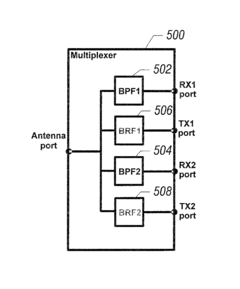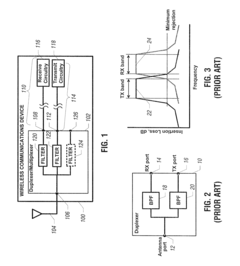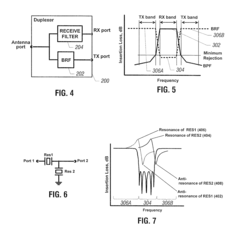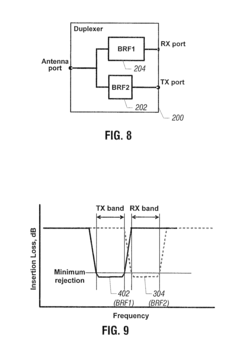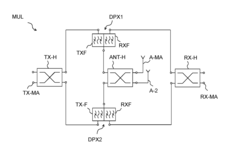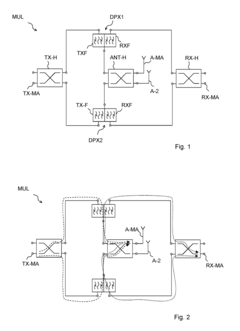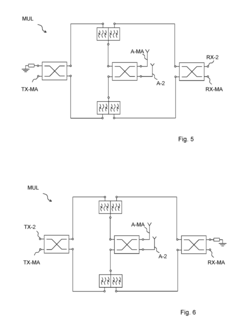Multiplexer Technologies Transforming Mobile Networks
JUL 13, 20258 MIN READ
Generate Your Research Report Instantly with AI Agent
Patsnap Eureka helps you evaluate technical feasibility & market potential.
Multiplexer Evolution
Multiplexer technologies have undergone significant evolution in mobile networks, transforming the way data is transmitted and processed. The journey began with simple time-division multiplexing (TDM) systems in early mobile networks, which allowed multiple users to share a single communication channel by allocating time slots to each user.
As mobile networks progressed to 2G and 3G, more advanced multiplexing techniques emerged. Code Division Multiple Access (CDMA) became a prominent technology, enabling multiple users to transmit simultaneously on the same frequency by using unique spreading codes. This marked a significant leap in network capacity and efficiency.
The advent of 4G LTE networks introduced Orthogonal Frequency Division Multiplexing (OFDM), which divides the available spectrum into multiple narrow subcarriers. OFDM greatly improved spectral efficiency and resistance to multipath fading, allowing for higher data rates and better performance in challenging radio environments.
With the transition to 5G, multiplexing technologies have taken another leap forward. 5G networks employ advanced versions of OFDM, such as Cyclic Prefix OFDM (CP-OFDM) and Discrete Fourier Transform-spread-OFDM (DFT-s-OFDM). These techniques offer enhanced flexibility and scalability to support diverse use cases and service requirements.
Moreover, 5G introduces massive Multiple-Input Multiple-Output (MIMO) technology, which uses large arrays of antennas to multiplex spatial streams. This allows for beamforming and spatial multiplexing, significantly increasing network capacity and spectral efficiency.
The evolution of multiplexer technologies has also seen advancements in network virtualization and software-defined networking (SDN). These approaches enable dynamic allocation of network resources and flexible multiplexing schemes, adapting to changing traffic patterns and user demands in real-time.
Looking ahead, future multiplexing technologies are expected to leverage artificial intelligence and machine learning algorithms for predictive resource allocation and intelligent interference management. Additionally, research is ongoing in areas such as non-orthogonal multiple access (NOMA) and full-duplex communication, which promise to further enhance spectral efficiency and network capacity in future mobile networks.
As mobile networks progressed to 2G and 3G, more advanced multiplexing techniques emerged. Code Division Multiple Access (CDMA) became a prominent technology, enabling multiple users to transmit simultaneously on the same frequency by using unique spreading codes. This marked a significant leap in network capacity and efficiency.
The advent of 4G LTE networks introduced Orthogonal Frequency Division Multiplexing (OFDM), which divides the available spectrum into multiple narrow subcarriers. OFDM greatly improved spectral efficiency and resistance to multipath fading, allowing for higher data rates and better performance in challenging radio environments.
With the transition to 5G, multiplexing technologies have taken another leap forward. 5G networks employ advanced versions of OFDM, such as Cyclic Prefix OFDM (CP-OFDM) and Discrete Fourier Transform-spread-OFDM (DFT-s-OFDM). These techniques offer enhanced flexibility and scalability to support diverse use cases and service requirements.
Moreover, 5G introduces massive Multiple-Input Multiple-Output (MIMO) technology, which uses large arrays of antennas to multiplex spatial streams. This allows for beamforming and spatial multiplexing, significantly increasing network capacity and spectral efficiency.
The evolution of multiplexer technologies has also seen advancements in network virtualization and software-defined networking (SDN). These approaches enable dynamic allocation of network resources and flexible multiplexing schemes, adapting to changing traffic patterns and user demands in real-time.
Looking ahead, future multiplexing technologies are expected to leverage artificial intelligence and machine learning algorithms for predictive resource allocation and intelligent interference management. Additionally, research is ongoing in areas such as non-orthogonal multiple access (NOMA) and full-duplex communication, which promise to further enhance spectral efficiency and network capacity in future mobile networks.
Mobile Network Demands
The mobile network industry is experiencing unprecedented growth in data traffic, driven by the proliferation of smartphones, the Internet of Things (IoT), and emerging technologies like 5G. This surge in demand is placing immense pressure on existing network infrastructure, necessitating innovative solutions to enhance capacity and efficiency. Mobile network operators are facing challenges in meeting the ever-increasing bandwidth requirements while maintaining quality of service and minimizing latency.
The exponential rise in mobile data consumption is primarily attributed to video streaming, social media, and cloud-based applications. High-definition video content, in particular, has become a dominant force in mobile data traffic, accounting for a significant portion of network load. Additionally, the growing adoption of IoT devices and machine-to-machine communications is contributing to the strain on mobile networks, as these technologies require constant connectivity and data exchange.
5G technology is expected to play a crucial role in addressing these demands, offering faster speeds, lower latency, and increased network capacity. However, the implementation of 5G networks also brings new challenges, such as the need for denser small cell deployments and more efficient spectrum utilization. This transition is driving the development of advanced multiplexing technologies to maximize the use of available spectrum and improve overall network performance.
The increasing demand for mobile connectivity in various sectors, including healthcare, transportation, and smart cities, is further fueling the need for robust and scalable network solutions. These applications often require real-time data processing and low-latency communications, putting additional pressure on mobile networks to deliver consistent and reliable performance.
To meet these evolving demands, mobile network operators are exploring various strategies, including network densification, spectrum refarming, and the implementation of advanced antenna technologies. Multiplexer technologies are emerging as a key enabler in this context, offering the potential to significantly enhance network capacity and efficiency. These technologies allow for the simultaneous transmission of multiple data streams over a single channel, effectively multiplying the capacity of existing network infrastructure.
As mobile networks continue to evolve, the industry is witnessing a shift towards more flexible and software-defined architectures. This transition is enabling operators to adapt more quickly to changing traffic patterns and implement new services with greater agility. The integration of artificial intelligence and machine learning algorithms is also becoming increasingly important in optimizing network performance and predicting future capacity requirements.
The exponential rise in mobile data consumption is primarily attributed to video streaming, social media, and cloud-based applications. High-definition video content, in particular, has become a dominant force in mobile data traffic, accounting for a significant portion of network load. Additionally, the growing adoption of IoT devices and machine-to-machine communications is contributing to the strain on mobile networks, as these technologies require constant connectivity and data exchange.
5G technology is expected to play a crucial role in addressing these demands, offering faster speeds, lower latency, and increased network capacity. However, the implementation of 5G networks also brings new challenges, such as the need for denser small cell deployments and more efficient spectrum utilization. This transition is driving the development of advanced multiplexing technologies to maximize the use of available spectrum and improve overall network performance.
The increasing demand for mobile connectivity in various sectors, including healthcare, transportation, and smart cities, is further fueling the need for robust and scalable network solutions. These applications often require real-time data processing and low-latency communications, putting additional pressure on mobile networks to deliver consistent and reliable performance.
To meet these evolving demands, mobile network operators are exploring various strategies, including network densification, spectrum refarming, and the implementation of advanced antenna technologies. Multiplexer technologies are emerging as a key enabler in this context, offering the potential to significantly enhance network capacity and efficiency. These technologies allow for the simultaneous transmission of multiple data streams over a single channel, effectively multiplying the capacity of existing network infrastructure.
As mobile networks continue to evolve, the industry is witnessing a shift towards more flexible and software-defined architectures. This transition is enabling operators to adapt more quickly to changing traffic patterns and implement new services with greater agility. The integration of artificial intelligence and machine learning algorithms is also becoming increasingly important in optimizing network performance and predicting future capacity requirements.
Multiplexer Challenges
Multiplexer technologies have revolutionized mobile networks, but they also face significant challenges that need to be addressed for continued advancement. One of the primary obstacles is the increasing complexity of multiplexer designs as network demands grow. As mobile data traffic continues to surge, multiplexers must handle higher bandwidths and more diverse signal types, leading to intricate architectures that are difficult to design, implement, and maintain.
Signal interference and crosstalk pose another major challenge for multiplexers in mobile networks. As the density of channels increases, the risk of adjacent signals interfering with each other rises, potentially degrading overall network performance. Engineers must develop innovative techniques to minimize these effects while maintaining high channel capacity and signal quality.
Power consumption is a critical concern, especially in the context of 5G and future network generations. Multiplexers need to process vast amounts of data at high speeds, which can lead to significant energy requirements. Balancing performance with energy efficiency is a delicate task that requires continuous innovation in both hardware design and signal processing algorithms.
The integration of multiplexers with other network components presents additional challenges. As networks become more complex and heterogeneous, ensuring seamless interoperability between multiplexers and various network elements becomes increasingly difficult. This integration challenge extends to software-defined networking (SDN) and network function virtualization (NFV) paradigms, where multiplexers must adapt to dynamic network configurations.
Scalability is another hurdle that multiplexer technologies face. As networks expand and evolve, multiplexers must be able to scale efficiently to accommodate growing numbers of users, devices, and data streams. This scalability must be achieved without compromising performance or significantly increasing costs, which is a considerable engineering challenge.
Lastly, the rapid pace of technological change in mobile networks presents a continuous challenge for multiplexer development. Designers must anticipate future network requirements and create flexible, future-proof solutions that can adapt to emerging technologies and standards. This forward-looking approach is essential but fraught with uncertainties and risks in a rapidly evolving technological landscape.
Signal interference and crosstalk pose another major challenge for multiplexers in mobile networks. As the density of channels increases, the risk of adjacent signals interfering with each other rises, potentially degrading overall network performance. Engineers must develop innovative techniques to minimize these effects while maintaining high channel capacity and signal quality.
Power consumption is a critical concern, especially in the context of 5G and future network generations. Multiplexers need to process vast amounts of data at high speeds, which can lead to significant energy requirements. Balancing performance with energy efficiency is a delicate task that requires continuous innovation in both hardware design and signal processing algorithms.
The integration of multiplexers with other network components presents additional challenges. As networks become more complex and heterogeneous, ensuring seamless interoperability between multiplexers and various network elements becomes increasingly difficult. This integration challenge extends to software-defined networking (SDN) and network function virtualization (NFV) paradigms, where multiplexers must adapt to dynamic network configurations.
Scalability is another hurdle that multiplexer technologies face. As networks expand and evolve, multiplexers must be able to scale efficiently to accommodate growing numbers of users, devices, and data streams. This scalability must be achieved without compromising performance or significantly increasing costs, which is a considerable engineering challenge.
Lastly, the rapid pace of technological change in mobile networks presents a continuous challenge for multiplexer development. Designers must anticipate future network requirements and create flexible, future-proof solutions that can adapt to emerging technologies and standards. This forward-looking approach is essential but fraught with uncertainties and risks in a rapidly evolving technological landscape.
Current Multiplexing
01 Network multiplexing and demultiplexing techniques
This technology focuses on efficient data transmission by combining multiple signals into a single signal for transmission and then separating them at the receiving end. It enables better utilization of network resources and improves overall network performance. Multiplexing techniques include time-division multiplexing (TDM), frequency-division multiplexing (FDM), and wavelength-division multiplexing (WDM).- Network Transformation using Software-Defined Networking (SDN): Software-Defined Networking (SDN) is a key technology for network transformation, allowing for centralized control and programmability of network infrastructure. SDN separates the control plane from the data plane, enabling more flexible and efficient network management. This approach facilitates the implementation of advanced multiplexing techniques and dynamic resource allocation in modern networks.
- Multiplexing Techniques for Network Optimization: Advanced multiplexing techniques are crucial for optimizing network performance and capacity. These include time-division multiplexing (TDM), frequency-division multiplexing (FDM), and wavelength-division multiplexing (WDM) for optical networks. Such techniques enable efficient use of network resources, increased data throughput, and improved scalability in transformed network architectures.
- Network Virtualization and Cloud Integration: Network virtualization technologies play a significant role in network transformation by creating logical network segments over physical infrastructure. This approach, combined with cloud integration, enables more flexible and scalable network architectures. It allows for better resource utilization, improved network agility, and enhanced support for diverse applications and services.
- Adaptive and Cognitive Multiplexing Systems: Adaptive and cognitive multiplexing systems use machine learning and AI techniques to optimize network performance dynamically. These systems can adjust multiplexing parameters in real-time based on network conditions, traffic patterns, and application requirements. This approach enhances network efficiency, reliability, and quality of service in transformed network environments.
- Hardware Innovations for Multiplexer Technologies: Hardware innovations play a crucial role in advancing multiplexer technologies for network transformation. This includes the development of high-speed, low-latency multiplexer circuits, integrated photonic devices for optical multiplexing, and reconfigurable hardware platforms. These hardware advancements enable more efficient and flexible multiplexing solutions, supporting the increasing demands of transformed networks.
02 Software-defined networking (SDN) for network transformation
SDN separates the network's control plane from the data plane, allowing for more flexible and programmable network management. This approach enables dynamic reconfiguration of network resources, improves scalability, and facilitates the implementation of new network services. SDN controllers can manage multiple network devices and optimize traffic flow across the network.Expand Specific Solutions03 Network function virtualization (NFV) in multiplexer technologies
NFV involves implementing network functions as software on standard hardware, rather than using dedicated hardware appliances. This approach allows for greater flexibility, scalability, and cost-effectiveness in network infrastructure. NFV can be applied to various network functions, including multiplexing, routing, and load balancing, enabling more efficient use of network resources.Expand Specific Solutions04 Adaptive multiplexing for network optimization
Adaptive multiplexing techniques dynamically adjust multiplexing parameters based on network conditions and traffic patterns. This approach optimizes network performance by efficiently allocating bandwidth and reducing latency. It can involve real-time monitoring of network metrics and automatic adjustment of multiplexing strategies to maintain optimal performance.Expand Specific Solutions05 Integration of multiplexer technologies with emerging network paradigms
This involves combining multiplexer technologies with emerging network paradigms such as 5G, edge computing, and Internet of Things (IoT). The integration aims to enhance network capacity, reduce latency, and improve overall network efficiency. It includes techniques for seamless integration of multiplexing with advanced network architectures and protocols to support diverse application requirements.Expand Specific Solutions
Key Industry Players
The multiplexer technologies transforming mobile networks are in a dynamic growth phase, with the market expanding rapidly due to increasing demand for high-speed data transmission and network capacity. The technology is maturing, but still evolving, as major players like Qualcomm, Huawei, and Ericsson drive innovation. These companies, along with others such as Nokia and Samsung, are investing heavily in research and development to enhance multiplexing techniques for 5G and beyond. The competitive landscape is intense, with established telecom equipment manufacturers competing against newer entrants specializing in advanced multiplexing solutions. As the technology becomes more sophisticated, we're seeing a trend towards integration of multiplexing with other advanced network technologies to optimize overall mobile network performance.
QUALCOMM, Inc.
Technical Solution: Qualcomm has developed advanced multiplexer technologies for 5G networks, including their QET6100 Antenna Tuning solution. This technology utilizes adaptive impedance matching and dynamic antenna tuning to optimize RF performance across multiple frequency bands[1]. The company's multiplexer solutions incorporate their proprietary modem-antenna interface to enable real-time tuning based on network conditions and user interaction. Qualcomm's multiplexers support carrier aggregation, allowing simultaneous use of multiple frequency bands to increase data throughput[2]. Their latest multiplexer designs also integrate with their 5G mmWave modules, enabling efficient switching between sub-6 GHz and mmWave frequencies for seamless coverage[3].
Strengths: Industry-leading 5G modem integration, extensive patent portfolio, and strong relationships with mobile device manufacturers. Weaknesses: Dependence on smartphone market cycles and increasing competition in the 5G chip market.
Huawei Technologies Co., Ltd.
Technical Solution: Huawei has developed innovative multiplexer technologies for 5G networks, focusing on improving spectrum efficiency and network capacity. Their advanced multiplexer solutions incorporate AI-driven dynamic spectrum sharing (DSS) technology, allowing seamless coexistence of 4G and 5G networks on the same frequency bands[1]. Huawei's multiplexers utilize massive MIMO and beamforming techniques to enhance signal quality and reduce interference in dense urban environments[2]. The company has also introduced their "Super Uplink" technology, which combines TDD and FDD uplink carriers to significantly boost uplink speeds in 5G networks[3]. Additionally, Huawei's multiplexers support flexible spectrum access and carrier aggregation across low, mid, and high-frequency bands, enabling operators to maximize their spectrum resources[4].
Strengths: Strong R&D capabilities, comprehensive end-to-end 5G solutions, and significant market share in many regions. Weaknesses: Geopolitical challenges and restrictions in some markets, particularly in Western countries.
Innovative Patents
Duplexer/multiplexer having filters that include at least one band reject filter
PatentActiveUS8204031B2
Innovation
- A multi-port path selection structure for wireless communications devices that includes a band reject filter connected to the transmit path and a bandpass or band reject filter connected to the receive path, using acoustic-type resonators arranged in a ladder-type configuration to reduce acousto-migration and enhance power handling.
Multiplexer and mobile communication device comprising a multiplexer
PatentActiveUS20170077986A1
Innovation
- A multiplexer design comprising two duplexers and three hybrids, where each duplexer is electrically connected in parallel to the hybrids, allowing for phase shifting and tunability, enabling simultaneous signal transfer in multiple paths without the need for additional filters or switches, thus maintaining superior isolation and compactness.
Spectrum Efficiency
Spectrum efficiency is a critical factor in the evolution of mobile networks, particularly as the demand for data-intensive applications continues to grow exponentially. Multiplexer technologies play a pivotal role in enhancing spectrum efficiency by enabling multiple signals to share the same frequency band simultaneously. This approach maximizes the utilization of available spectrum resources, which are inherently limited and increasingly congested.
One of the key multiplexer technologies transforming mobile networks is Orthogonal Frequency Division Multiplexing (OFDM). OFDM divides the available spectrum into multiple orthogonal subcarriers, each carrying a portion of the user's data. This technique allows for efficient use of bandwidth and provides resilience against multipath fading and interference. Advanced versions of OFDM, such as OFDMA (Orthogonal Frequency Division Multiple Access), further improve spectrum efficiency by dynamically allocating subcarriers to different users based on their data requirements and channel conditions.
Another significant advancement in multiplexer technology is Massive MIMO (Multiple-Input Multiple-Output). This technique employs a large number of antennas at the base station to serve multiple users simultaneously on the same frequency resources. By leveraging spatial multiplexing and beamforming, Massive MIMO significantly increases spectral efficiency, especially in dense urban environments where demand for capacity is highest.
Carrier aggregation is yet another multiplexer technology that enhances spectrum efficiency. It allows mobile network operators to combine multiple carrier frequencies across different spectrum bands, effectively increasing the bandwidth available to users. This technology is particularly useful in scenarios where contiguous spectrum is scarce, enabling operators to make the most of their fragmented spectrum holdings.
Non-Orthogonal Multiple Access (NOMA) is an emerging multiplexer technology that promises to further improve spectrum efficiency. Unlike traditional orthogonal multiple access schemes, NOMA allows multiple users to share the same time-frequency resources by exploiting power domain multiplexing. This approach can potentially support a higher number of connected devices, making it particularly suitable for IoT applications and ultra-dense networks.
As mobile networks continue to evolve towards 5G and beyond, these multiplexer technologies will play an increasingly important role in meeting the growing demand for high-speed, low-latency connectivity. The ongoing research and development in this field focus on further refining these technologies to achieve even higher levels of spectrum efficiency, paving the way for more advanced mobile services and applications in the future.
One of the key multiplexer technologies transforming mobile networks is Orthogonal Frequency Division Multiplexing (OFDM). OFDM divides the available spectrum into multiple orthogonal subcarriers, each carrying a portion of the user's data. This technique allows for efficient use of bandwidth and provides resilience against multipath fading and interference. Advanced versions of OFDM, such as OFDMA (Orthogonal Frequency Division Multiple Access), further improve spectrum efficiency by dynamically allocating subcarriers to different users based on their data requirements and channel conditions.
Another significant advancement in multiplexer technology is Massive MIMO (Multiple-Input Multiple-Output). This technique employs a large number of antennas at the base station to serve multiple users simultaneously on the same frequency resources. By leveraging spatial multiplexing and beamforming, Massive MIMO significantly increases spectral efficiency, especially in dense urban environments where demand for capacity is highest.
Carrier aggregation is yet another multiplexer technology that enhances spectrum efficiency. It allows mobile network operators to combine multiple carrier frequencies across different spectrum bands, effectively increasing the bandwidth available to users. This technology is particularly useful in scenarios where contiguous spectrum is scarce, enabling operators to make the most of their fragmented spectrum holdings.
Non-Orthogonal Multiple Access (NOMA) is an emerging multiplexer technology that promises to further improve spectrum efficiency. Unlike traditional orthogonal multiple access schemes, NOMA allows multiple users to share the same time-frequency resources by exploiting power domain multiplexing. This approach can potentially support a higher number of connected devices, making it particularly suitable for IoT applications and ultra-dense networks.
As mobile networks continue to evolve towards 5G and beyond, these multiplexer technologies will play an increasingly important role in meeting the growing demand for high-speed, low-latency connectivity. The ongoing research and development in this field focus on further refining these technologies to achieve even higher levels of spectrum efficiency, paving the way for more advanced mobile services and applications in the future.
Network Virtualization
Network virtualization is revolutionizing the landscape of mobile networks, offering unprecedented flexibility and efficiency in resource allocation. This technology enables the creation of multiple virtual networks on a single physical infrastructure, allowing for dynamic allocation of network resources based on demand. In the context of multiplexer technologies transforming mobile networks, network virtualization plays a crucial role in optimizing network performance and enhancing service delivery.
The implementation of network virtualization in mobile networks involves the abstraction of physical network components into software-defined entities. This abstraction layer allows for the creation of isolated virtual networks, each capable of supporting different services or applications. By decoupling the network functions from the underlying hardware, operators can achieve greater agility in network management and service deployment.
One of the key benefits of network virtualization in mobile networks is the ability to slice the network into multiple virtual segments. Network slicing enables operators to create dedicated virtual networks for specific use cases, such as IoT, autonomous vehicles, or high-bandwidth applications. This granular control over network resources ensures that each service receives the appropriate level of performance and security.
Furthermore, network virtualization facilitates the implementation of software-defined networking (SDN) and network function virtualization (NFV) in mobile networks. These technologies work in tandem to create a more programmable and adaptable network infrastructure. SDN provides centralized control and management of network resources, while NFV allows for the virtualization of network functions traditionally performed by dedicated hardware appliances.
The integration of network virtualization with multiplexer technologies in mobile networks enables more efficient use of spectrum resources. Virtual network functions can be dynamically allocated and scaled based on traffic patterns and user demands, optimizing the utilization of available bandwidth. This flexibility is particularly valuable in 5G and beyond networks, where diverse service requirements and high-density deployments necessitate intelligent resource management.
As mobile networks continue to evolve, network virtualization will play an increasingly important role in enabling new services and improving network performance. The ability to create tailored virtual networks for specific applications or customer segments opens up new revenue streams for operators and enhances the overall user experience. Moreover, the scalability and flexibility offered by network virtualization position it as a key enabler for future advancements in mobile network technologies.
The implementation of network virtualization in mobile networks involves the abstraction of physical network components into software-defined entities. This abstraction layer allows for the creation of isolated virtual networks, each capable of supporting different services or applications. By decoupling the network functions from the underlying hardware, operators can achieve greater agility in network management and service deployment.
One of the key benefits of network virtualization in mobile networks is the ability to slice the network into multiple virtual segments. Network slicing enables operators to create dedicated virtual networks for specific use cases, such as IoT, autonomous vehicles, or high-bandwidth applications. This granular control over network resources ensures that each service receives the appropriate level of performance and security.
Furthermore, network virtualization facilitates the implementation of software-defined networking (SDN) and network function virtualization (NFV) in mobile networks. These technologies work in tandem to create a more programmable and adaptable network infrastructure. SDN provides centralized control and management of network resources, while NFV allows for the virtualization of network functions traditionally performed by dedicated hardware appliances.
The integration of network virtualization with multiplexer technologies in mobile networks enables more efficient use of spectrum resources. Virtual network functions can be dynamically allocated and scaled based on traffic patterns and user demands, optimizing the utilization of available bandwidth. This flexibility is particularly valuable in 5G and beyond networks, where diverse service requirements and high-density deployments necessitate intelligent resource management.
As mobile networks continue to evolve, network virtualization will play an increasingly important role in enabling new services and improving network performance. The ability to create tailored virtual networks for specific applications or customer segments opens up new revenue streams for operators and enhances the overall user experience. Moreover, the scalability and flexibility offered by network virtualization position it as a key enabler for future advancements in mobile network technologies.
Unlock deeper insights with Patsnap Eureka Quick Research — get a full tech report to explore trends and direct your research. Try now!
Generate Your Research Report Instantly with AI Agent
Supercharge your innovation with Patsnap Eureka AI Agent Platform!
